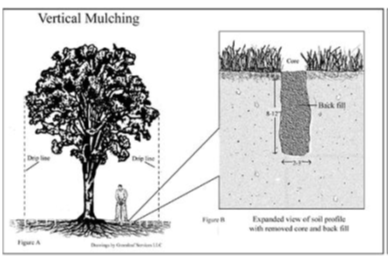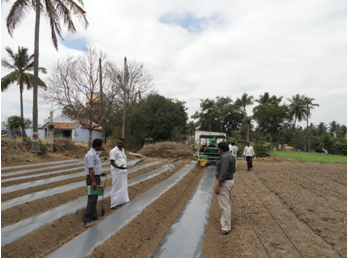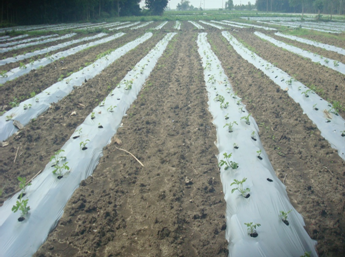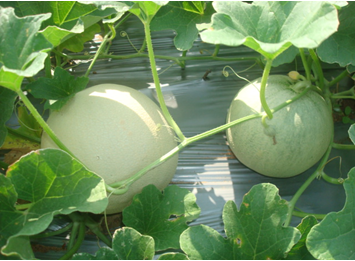
|
|||||||||||||
Soil and Water Conservation Technologies :: MULCHING |
|||||||||||||
MULCHING
Mulching Mulch is a layer of material applied to the surface of an area of soil. Mulching helps prevent soil erosion Mulch prevents rain from hitting the soil directly, reducingthe impact of the water drops. Water soaks into the soilgradually instead washing the soil away Mulching adds organic matter to the soil Soil that is high in organic matter is very much alive. In just one pinch of soil, there are about abillion individual living organisms, perhaps ten thousand distinct species of microbes. As thesemicrobes decompose organic matter, it supplies nutrients needed by growing plants. The beauty ofthis natural nutrient cycle is that nutrients are released in harmony with the needs of the plants.When environmental conditions are favorable for rapid plant growth, the same conditions favor arapid release of nutrients from the organic matter Mulching feeds soil life and improves soil structure When a mulch of organic matter is added to the surface of the soil, it decays producing slimes andgums that help to form and stabilize soil structure. The extra organic matter is food for soil creatures.These burrow their way through the soil, mixing the organic matter in and creating passagewayswithin the soil through which air and water can infiltrate. In this way, mulching can help loosen up heavy clay soils, making it easier for the farmer to work, and making it easier for plant roots andshoots to push their way through.Some people call earthworms “a farmer’s best friends”. Asearthworms multiply, the soil becomes looser and moreporous - a better place for plant roots to grow.Mulching also preventsthe soil from getting a hardcrust. When raindrops hit baresoil in a heavy rainstorm, it breaks into smallerpieces. These pieces stick together and form a hardcrust when the soil dries. This crust makes it difficultfor water to soak into the ground. It also makes ithard for young plants to push through the soil crust.Mulch is a protective cover for the soil, sheltering thesoil from hard-hitting rain Mulching adds nutrients to the soil Mulch around crop plants mimics the litter layer of a forest floor. The nutrients in the mulch aregradually released and taken up by the crops. Mulching is cheaper than chemical fertilizers, andbecause it also improves soil structure, the nutrients will not be washed away or leached from thesoil by heavy rain Mulch decreases water loss due to evaporation Mulch reflects a lot of the sun that otherwise beats down on the soil. This keeps the soil cooler andhelps prevent evaporation. This is especially important in hot, dry climates. Also, by slowing downrainwater run-off, mulch increases the amount of water that soaks into the soil. The loose soilstructure, created by the soil life fed by the mulch, helps hold water in the soil. And more water inthe soil means more water for your crops.Withmulch, it may be possible to grow crops liketomatoes and cucumbers where only drought tolerant crops grew before Are there any problems to look out for when mulching? There are some potential drawbacks to mulching which people should know about. For one thing,mulches may provide a good environment for pests. For example, slugs sometimes cause seriouslosses to crops such as beans when mulched. Harmful insects, mice, rats, rabbits and snakes mayalso find thick mulches an attractive habitat. Also, mulching can sometimes lead to a lack of nitrogenfor crop plants. The nitrogen can be locked up in the bacteria that are decomposing the freshorganic matter in the mulch. Nitrogen deficiency may make the crop plants more susceptible todisease. However, as a long-term strategy for soil improvement, the benefits of mulching far outweigh thepotential disadvantages. For many crops, mulching can increase yields, prevent erosion, and ensurethat your soil stays fertile for the future What materials can be used as mulch? You can mulch with whatever organic matter is readily available and transportable.* Commonmaterials include compost, manure, straw (crop stems and stalks), dry grass clippings, sawdust,leaves, and other left-over crop residues. Alternative mulching materials include black plasticsheeting, newspaper or cardboard. However these materials do not add nutrients to the soil orimprove its structure. It’s better not to use plant material from the same type of crops that you are growing. Forexample, maize residue should not be used as a mulch for maize as it might still be carryinginsects or diseases of maize. Green vegetation is not normally used as it can take a long time to decompose and can attractpests and fungal diseases.Experiment to see which mulches in your area last the longest. The longer the mulch lasts theless often you have to apply it How do you apply mulch? For large plants spread the mulch between the rows and aroundeach plant For small plants or seedlings apply it between the rows, notdirectly around the plants. In this way you will not encouragedisease, but you will still reduce weeds and add organic matter tothe soil. Try different thicknesses of mulch to see which worksbest for your cropsAlways apply mulches to a warm, wet soil. Mulch applied to a drysoil will keep the soil dry How thick should the mulch be? If you put mulch on too thickly, it might shade seedlings, so they will grow tall and spindly. Toomuch mulch can also prevent airflow and encourage disease. This can be especial problemin areas with a lot of rain To allow the germination of planted seeds through the mulch, a layer of less than 10cm shouldbe used To clear an area of land of persistent weeds a layer of 10cm or more can be used Isn’t mulching a lot of extra work? Actually, by improving the soil and helping to fight weeds, mulching can save gardeners time andwork in the long run. You will spend less time weeding and because a soil with lots of organic matteris looser, those weeds that do grow are a lot easier to pull out. Digging in a looser soil is also a loteasier. Plus, as mulching prevents water from evaporating from the surface of the soil, less wateringis necessary.However, it’s true to say that it would be a lot of work to carry in enough mulching material to coveran entire field. Sometimes farmers simply cut the weeds in their fields, right before planting, to forma mulch for their crops. Other farmers grow cover crops, which they chop up and leave as a mulchjust before food crops are planted (See also Action Sheet 39: Green Manure/Cover Crops forBiomass Transfer). Vertical Mulching Vertical mulching is the creating of holes around the base of a tree or shrub that is stressed. The holes are filled with a mixture of organic material. The back fill and aeration can dramatically improve root growth and reduce or eliminate stress caused in a lawn environment or construction damage Some of the reasons to Vertical Mulch are as follows:
To allow faster percolation of water in wet areas by changing soil structure and aerating
It is a relatively simple and unobtrusive process. The holes are created with an air spade or soil auger. starting a few feet out from the trunk and continued in a grid pattern (approximately 2’ apart) beyond the drip line. They are usually back filled with a mixture of compost, organic fertilizer, and Mychorizae. The actual fill may vary according to the individual needs of the plant treated. Some of the benefits are
Vertical mulching is one of the most effective ways to treat stressed trees and shrubs. The aeration and soil treatment create an environment that mimics nature and allows for greater nutrient uptake, increased root growth and the potential regeneration of a damaged root system. We like to follow up our Vertical mulching jobs with compost tea and humate applications to further help the root system repair and provide for itself. Source:http://www.paceproject.net/Userfiles/File/Soils/mulching.pdf Plastic Mulching
Source : Water Technology Centre, TNAU, Coimbatore
Updated on :April 2015 | |||||||||||||
| © All Rights Reserved. TNAU-2016. |
|||||||||||||








